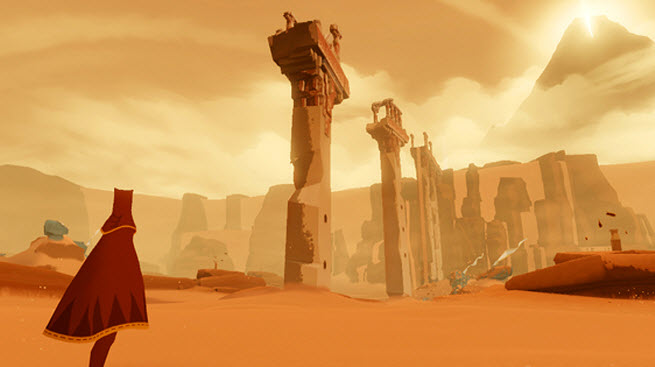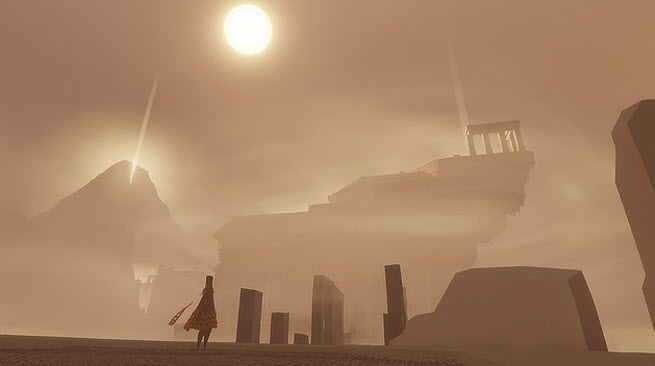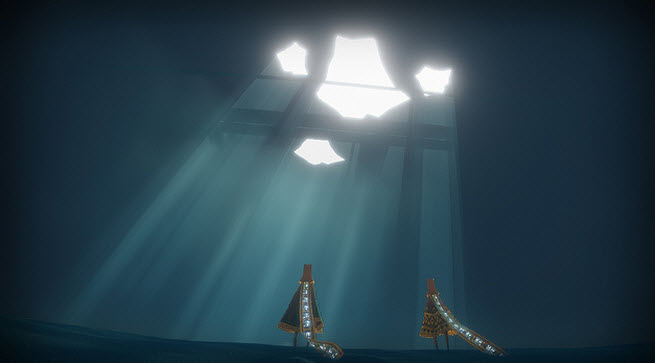Your first words when you start playing Journey, the new PlayStation Network game from Thatgamecompany, will be something like “Wow,” or “Cool!” From the moment you start walking through the sand, you know you’re in for a different kind of experience. The sand is mesmerizing, and since there is nothing else to do but walk through it, it captures your full attention.
Journey is the kind of game that has no violence or blood. The combined experience of Journey’s graphics, haunting music, and wordless story is one of the best arguments for classifying video games as a fine art. It is the kind of game that should reach a true mass market and generate an economic bonanza for anyone associated with it.
With Flower, the most beautiful element in the game was the realistically rendered grass that swayed with the wind and gave shape to something that was invisible. In Flower, you as the player were the wind in the dream of a dilapidated flower in the midst of a decaying urban jungle. The wind blew the grass and gave life to dead regions of the world and replaced them with colorful flowers, a process that was as beautiful as when the Wizard of Oz moved from black-and-white images to color as Dorothy arrived in land of the Munchkins.
WHAT YOU’LL LIKE
Incredible visuals
With Journey, the incredible visuals are presented to you right at the outset. You as the player are a robed character, completely masked in a red robe, not entirely human and neither male nor female in your form. In the distance is a mountain. It is split in two at its peak with a beam of light coming out of its middle crevice. It doesn’t seem all that far away, but that is the mirage.
Before you is a vast desert. The sand shimmers and shifts as the wind blows over it. You walk up a dune and leave a ripple of a realistically simulated sand in a wake behind you. You hear the sound of the sand as you stomp through it, and parts of it glitter like gold when the sun shines directly on it. The golden and fluid sand, like the grass in Flower, is the visual star of the show.
The controls are intuitive. You move forward by pushing the left analog stick on the controller and look around with the right stick. There is no time limit. You can proceed at your own pace, discovering how to move by surfing down a sand dune. Hit one button, and you will jump into the air. Hit another, and you will let out a kind of song, spitting out some odd symbols onto the screen as you do.
This is a game that can be played by anybody. It is utterly accessible. It has grand landscapes with fantastic views. As you walk forward, you will find buried buildings or enclosures that house flying ribbons. If you sing to them, they come to life and flow through the air. Little flying carpets give you energy, and you discover that you can use that energy to fly. When the energy runs out, you have to walk again.
So the basic mechanic of the game is to walk through the sand, find the ribbons, gain some energy, and use that to find your next puzzle or reward. The great thing about the game is it is efficient and well designed. The graphics work for the most part, and they don’t get in your way. If you want to speed through the game, you can. If you want to tarry, you can pause as you search the environment.
The story of Journey is one big metaphor. Since there is no dialogue, you have no knowledge of the places you walk through. The ancient ruins you find are a kind of mystery. You unravel some of that mystery as you uncover hieroglyphics on the walls, but that doesn’t seem to tell you much. At the end of each level, you are rewarded with the smiling approval of nun-like or angel-like robed characters. They appear to applaud your efforts and they open the path for you to forge ahead.
But the tale of Journey isn’t just about a walk in the sand. You run into obstacles. There are twists. The environment changes, and sometimes it seems so menacing that you won’t want to go ahead. Howling winds may make you want to stop. The path is a straight one, and you will wonder along the way about what your purpose is. It seems to be a lot like real life in that way: You don’t get an instruction manual for living. You get started moving, and you rarely stop. You overcome obstacles. Everything in Journey seems iconic, mysterious, and spiritual. But you can apply your own narrative on top of it. The beautiful orchestral music sets your mood at various points to be either happy, neutral, or somber.
The music makes your experience into an emotional one. A full orchestra with a chanting singer can lift you up. But as threats come near you, the music gets more menacing. A lone cello plays as you near the final steps of your Journey.
The weather also affects your state of mind. When the first drops of snow land on you, it’s a cool feeling. But when a snowstorm blows in your face, you’ll feel cold on the inside. And when you wander through the darkness, you feel both awe and fear.
How many video game stories can you remember that take you on an emotional path like this game does? It seems game developers rarely remember to stick to the fundamentals of a story arc in their games. Journey’s story seems like it has been stripped of all of the clutter and honed down to the fundamentals. Indeed, the developers of Journey seem to have thrown a lot of things out and come up with a minimalist story and game design. They took out everything except the most valuable part: your feelings as you play the game.
Multiplayer
Journey will be available for multiplayer play as well. Rather than lace up for a combat session, you can get together in the same game world with multiple people and explore it together, talking via headsets. You can discover the hidden history of the ancient world in a unique cooperative play mode with other people who share your experience. You can get through some of the levels faster with multiple people, but that’s not really the point. With a short game, the point of multiplayer is really to make you linger and stay longer in the experience.
[Update: I’ve been able to play through yet another time with multiple companions along the way. They come and go like spirits, so you don’t really know if they’re non-player characters or real people. You don’t sign up to get a multiplayer partner. The others just appear in your game. All you can do to communicate is sing to each other. But the emotion of the game changes when someone else arrives. You’re delighted that you aren’t on your journey alone. And for the most part, the other players help you play better. But at one juncture, the other player did something that prevented me from moving up to grab a resource. That was a little frustrating. But it didn’t affect my ability to move forward. At the end of the multiplayer session, the game tells you the names (or PlayStation Network handles) of the companions you met along the way.]
WHAT YOU WON’T LIKE
Time management problem
I have a bone to pick with Thatgamecompany. They work too slow. Come on! Such lazy developers. They came out with Flower, one of the most startling and original video games ever made — with a story as beautiful as Dr. Seuss’s The Lorax (the book, not the movie) — and then they sit around and do nothing for three years.
Now they’ve launched Journey. It’s a short three-hour experience available for $14.99 on the PlayStation Network. It’s another spectacularly innovative game. And now they’re probably going to sit on their butts for another three years. Speed it up, will ya! You guys are doing the most original work in gaming on any platform. We can’t wait that long for your next game.
 I jest, of course. Journey is an incredible video game, produced by a small team with about 11 developers — led by Kellee Santiago, Jenova Chen (pictured) Robin Hunicke and others.
I jest, of course. Journey is an incredible video game, produced by a small team with about 11 developers — led by Kellee Santiago, Jenova Chen (pictured) Robin Hunicke and others.
And yes, this is kind of a long way of saying that there isn’t much to dislike about Journey. The game isn’t for those among us who have been trained by years of experience to kill, maim, and tackle. If that’s what you want to do in video games, then you probably don’t have the patience for Journey. It’s also likely to be somewhat disappointing for those who simply want to know what is at the end of the Journey. The game is for people who want to explore and experience interesting things along the way.
The team ran with this idea, and they probably pursued it to a fault. There aren’t a lot of things you can do in Journey. It is a very linear experience,
where you go from one place to another in a pretty straight line. After all, you can always seen the mountain in the distance, so you always know which way to go. Even if you wanted to linger, there isn’t a lot for you to interact with. It almost seems as if the creators of Journey forgot that they could vary the story and leave you in more of an open world where you simply wander around. You can do that now, but it doesn’t seem like you can find much to do.
Journey’s creators at Thatgamecompany previously created Flow, Flower, and now Journey. The company was founded in 2006 by graduates of the University of Southern California’s School of Cinematic Arts. Flow debuted in 2007 on the PlayStation Network, and Flower debuted in 2009.
The studio’s game designers view the lack of violence as “de-empowering” the player. You feel helpless and tiny and all alone. The world makes you feel a sense of awe, wonder, and fear. If there is anything wrong with the game, it would have to be that the experience is kind of short. You can breeze right through it in about three hours. You’ll probably want to play it again, and it is a great game to play through with children of any age.
CONCLUSION
Journey is an archetypal story of the struggle we go through in life as we tackle any tough mission. You start out fresh, and your goal is formidable, but it’s not so far away. Then you find there are twists and turns, and the journey takes its toll on you. The game evokes an incredible amount of emotion from you, and it is the kind of game that its fans will play over and over. To employ a trite but true maxim, the Journey is the reward. The game is an amazing accomplishment in an industry that is focused on creating blockbusters with a $50 million budget. If it has a flaw, it is that the game is too short. But at least the developers at Thatgamecompany leave you wanting more.
Score: 90/100
Journey will be released on March 13, 2012, exclusively for the PlayStation 3 via download on the PlayStation Network. A downloadable code was provided by the publisher for the purpose of this review.
VentureBeat's mission is to be a digital town square for technical decision-makers to gain knowledge about transformative enterprise technology and transact. Learn More





